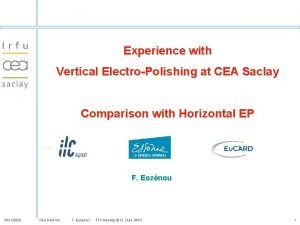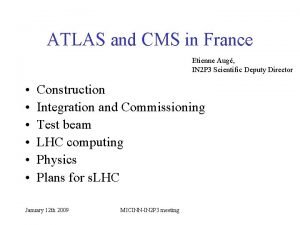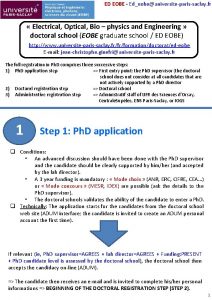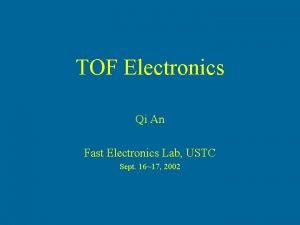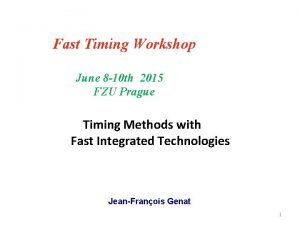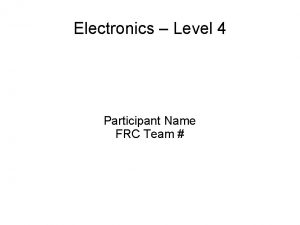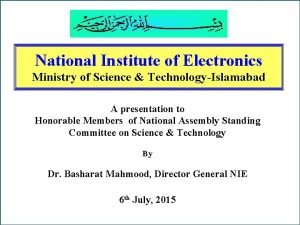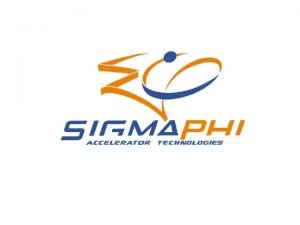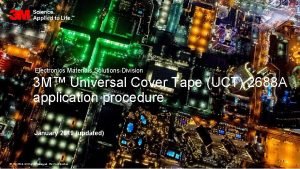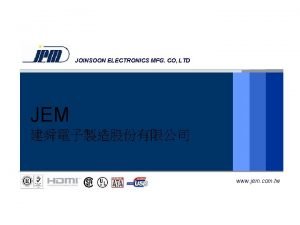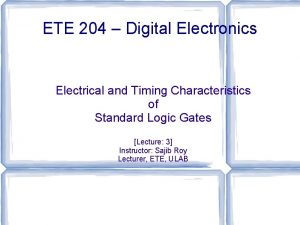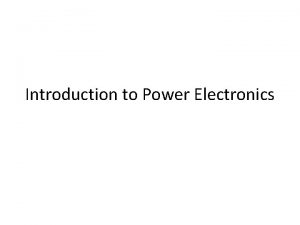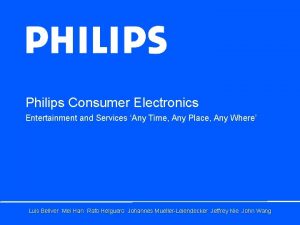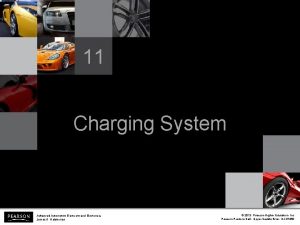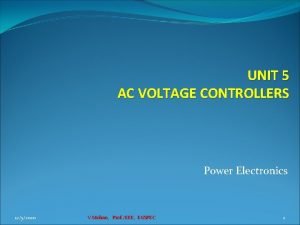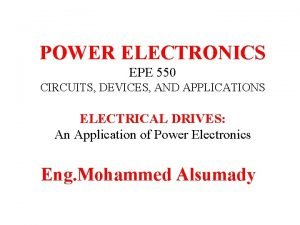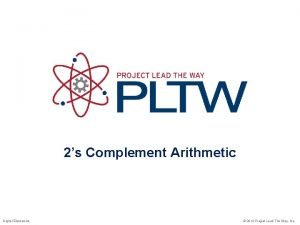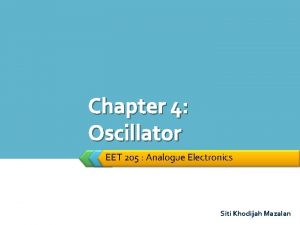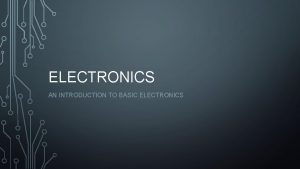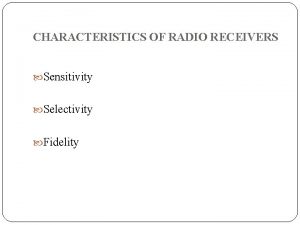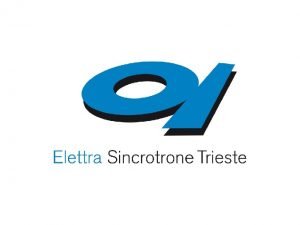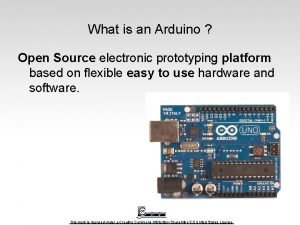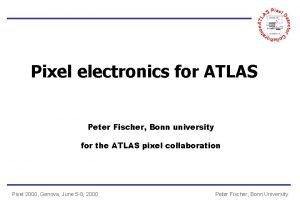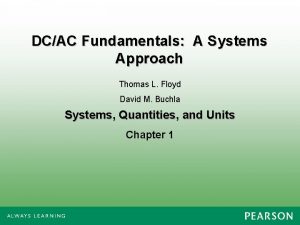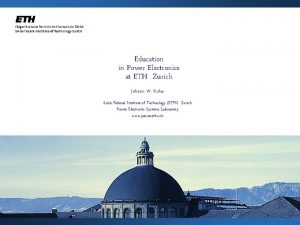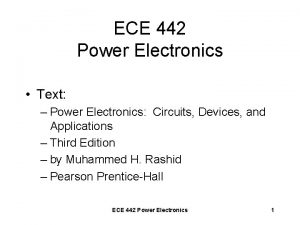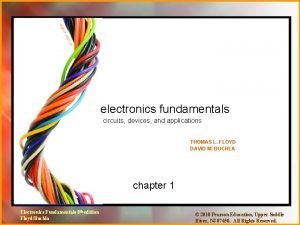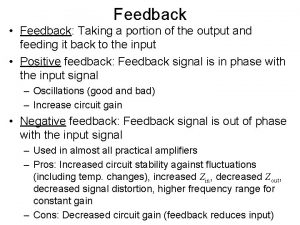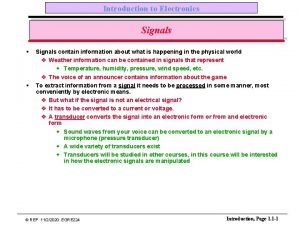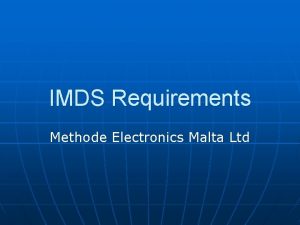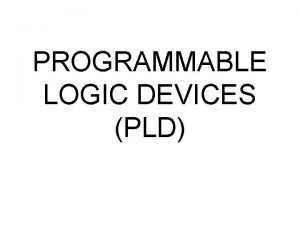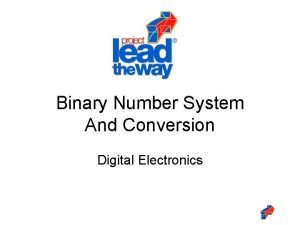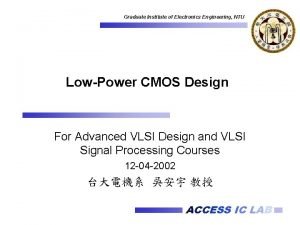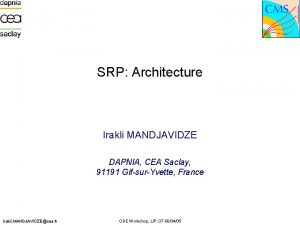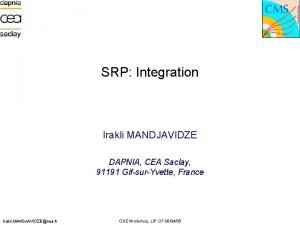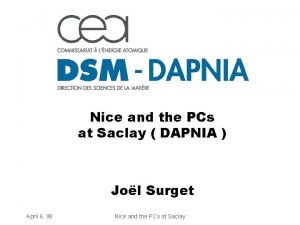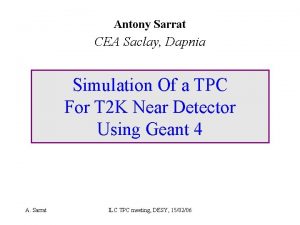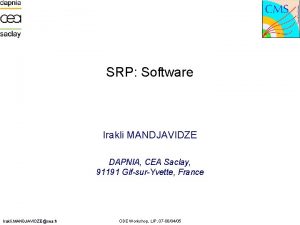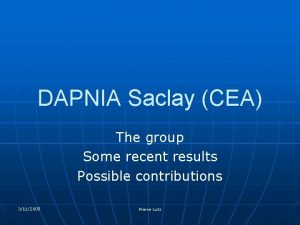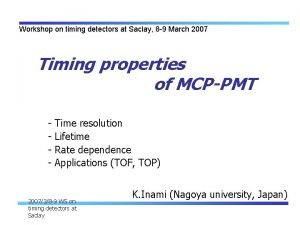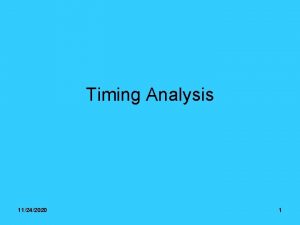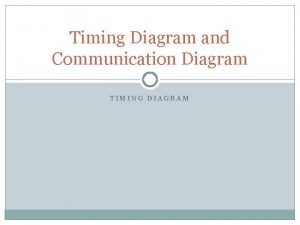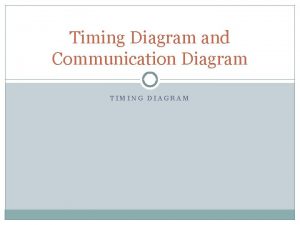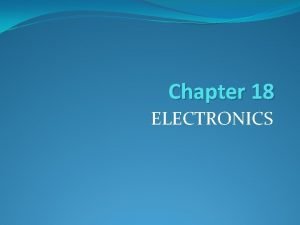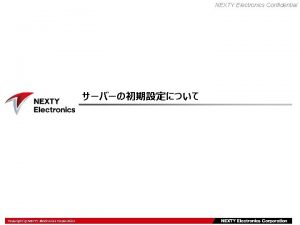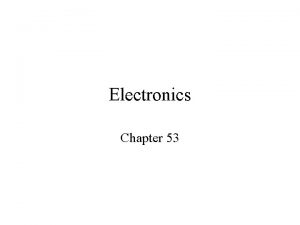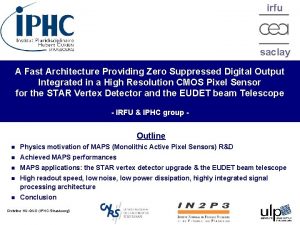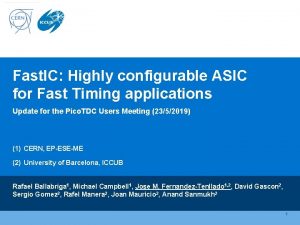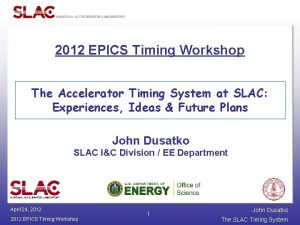Fast Timing Electronics Fast Timing Workshop DAPNIA Saclay


















































- Slides: 50

Fast Timing Electronics Fast Timing Workshop DAPNIA Saclay, March 8 -9 th 2007 Jean-François Genat LPNHE Paris Jean-François Genat, Fast Timing Workshop, DAPNIA, Saclay, March 8 -9 th 2007

Outline Fast detectors, fast signals Time pick-off Time to Digital conversion State of the art Technologies Conclusion Jean-François Genat, Fast Timing Workshop, March 8 th 2007, DAPNIA, Saclay

Fast detectors, fast signals Detector Signals: Moving charges (in an electric field): i(t)= n(t) q v(t) Bias Rise-time i’(t)= q [ n(t) v’(t) + n’(t) v(t)] Maximize n electron multiplication PMTs, MCPs dv/dt q. E/m electric field (in vacuum) dn/dt primary ionisation, multiplication v t. q. E /m electric field - Vacuum devices Electron multiplication Low capacitance High electric fields Jean-François Genat, Fast Timing Workshop, March 8 th 2007, DAPNIA, Saclay

Fast detectors Sub-nanosecond: 10 -100 ps rise-time Fast Signals Solid state • APDs • Silicon PMs • 3 D Silicon Rise-time Time resolution 102 107 104 300 ps 700 ps 500 ps 50 ps 200 ps ? 107 106 200 ps 150 ps 30 ps ? 50 ps 20 -30 ps 1 ps ? Very fast • • • Multi-anode/mesh PMTs MCP PMTs Multi anodes MCP PMTs Jean-François Genat, Fast Timing Workshop, March 8 th 2007, DAPNIA, Saclay

3 D Silicon detectors vs Planar Cinzia Da Via, Brunel, UK 11/2004 Jean-François Genat, Fast Timing Workshop, March 8 th 2007, DAPNIA, Saclay

MCP PMT single photon signals Actual MCP PMTs signals K. Inami et al Univ. Nagoya Tr = 500 ps tts= 30 ps MCP PMTs segmented anode signals simulation tts = 860 fs M. Sanders & H. Frisch, Univ. Chicago, Argonne N photo-electrons improves as Jean-François Genat, Fast Timing Workshop, March 8 th 2007, DAPNIA, Saclay

Fast detectors, fast signals Time pick-off Time to Digital conversion State of the art Technologies Conclusion Jean-François Genat, Fast Timing Workshop, March 8 th 2007, DAPNIA, Saclay

Fast timing Electronics gain-bandwidth should match: - Detector sensitivity Detector rise-time Example: Multi-anodes MCP PMTs: Rise-time: Corresponding Bandwidth: 25 ps 15 GHz Jean-François Genat, Fast Timing Workshop, March 8 th 2007, DAPNIA, Saclay

Effects of amplitude, rise-time Amplitude and/or Rise-time spectra translate into time spread Jean-François Genat, Fast Timing Workshop, March 8 th 2007, DAPNIA, Saclay

Effect of noise Time spread proportional to rise-time Jean-François Genat, Fast Timing Workshop, March 8 th 2007, DAPNIA, Saclay

Leading edge noise 1 Slope 1/t s. A Threshold st t Effects of noise Time spread proportional to rise-time Jean-François Genat, Fast Timing Workshop, March 8 th 2007, DAPNIA, Saclay

Other effects Walk: Discriminator delay depends on slope across threshold (detector rise-time + amplifier) Use appropriate (gain x bandwidth) technology Jean-François Genat, Fast Timing Workshop, March 8 th 2007, DAPNIA, Saclay

Zero crossing Use zero-crossing of signal derivative Detects signal’s maximum Derivative Zero-crossing Delay Signal Trigger threshold Reject HF noise from signal derivative delay Jean-François Genat, Fast Timing Workshop, March 8 th 2007, DAPNIA, Saclay

Double Threshold High Threshold to trigger Low threshold to time Lo thresh Delay Signal Hi thresh Avoids noise on low threshold Decision on very first signal rise delay Jean-François Genat, Fast Timing Workshop, March 8 th 2007, DAPNIA, Saclay

Constant Fraction If rise-time proportional to amplitude, use constant-fraction 1 Leading edge OK If no rise-time dependence with amplitude. Leading edge OK But detector presumably saturated, and slown down ! Constant fraction Leading edge errors If pulse shape independent of amplitude, use Constant fraction Jean-François Genat, Fast Timing Workshop, March 8 th 2007, DAPNIA, Saclay

Leading Edge vs CFD Jean-François Genat, Fast Timing Workshop, March 8 th 2007, DAPNIA, Saclay

Constant Fraction Three main parameters: Trigger threshold Delay Fraction Maximize slope at zero-crossing Carefully optimize wrt signals properties H. Spieler [IEEE NS 29 June 1982 pp 1142 -1158 ] T. J. Paulus [IEEE NS 32 June 1985 pp 1242 -1249] Jean-François Genat, Fast Timing Workshop, March 8 th 2007, DAPNIA, Saclay

Leading edge + ADC • If peak amplitude is measured, leading edge be compensated off-line can Results compare with CFD technique (IEEE NSS 2006 San Diego) Jean-François Genat, Fast Timing Workshop, March 8 th 2007, DAPNIA, Saclay

Pulse sampling Digitize samples over pedestal and signal Fast analog sampler + ADC: [E. Delagnes, Saclay, this workshop] Assuming the signal waveform is known from the detector and electronics properties: Least square fit yields: • Amplitude • Time Iterate with new values until convergence LSQF: [W. E. Cleland E. G. Stern. NIM A 338 pp 467 -497] • All samples contribute to timing estimation • Very robust to noise Jean-François Genat, Fast Timing Workshop, March 8 th 2007, DAPNIA, Saclay

Pulse sampling MATLAB Simulation with Silicon signals Better compared to CFD by a factor of two depending on noise properties and signal waveform statistics - MATLAB simulation package (JFG) Jean-François Genat, Fast Timing Workshop, March 8 th 2007, DAPNIA, Saclay

System issues • • • Drifts due to environmental conditions Power supplies drifts and noise Cables/fibers instabilities - Cable has shorter group delay, and even higher bandwidth, may pick-up noise - Micro-coax makes a come-back Jean-François Genat, Fast Timing Workshop, March 8 th 2007, DAPNIA, Saclay

Outline Fast detectors, Fast signals Time pick-off Time to Digital conversion State of the art Technologies Conclusion Jean-François Genat, Fast Timing Workshop, March 8 th 2007, DAPNIA, Saclay

Time to Digital Coding “Coarse” ( < 1 GHz) time coding use counters “Fine” (1 -1000 ps) time coding uses either or Time to Amplitude coding and ADC Digital delay lines phased locked on clock (DLL) Both techniques can be differential or not If short time range only is required, single TAC or DLL OK. Jean-François Genat, Fast Timing Workshop, March 8 th 2007, DAPNIA, Saclay

Architecture Clock Counter Synchro Start Stop Fine time MSB LSB Storage Jean-François Genat, Fast Timing Workshop, March 8 th 2007, DAPNIA, Saclay

Fine timing: Time to Amplitude Converter A voltage ramp is triggered on ‘Start’, stopped on “Stop” Stop can be a clock edge Amplitude is coded with a conventional ADC To ADC d ADC Start d Stop Jean-François Genat, Fast Timing Workshop, March 8 th 2007, DAPNIA, Saclay

Differential TAC Différential: Same as above, ramp goes up at rate Time is stretched by , down at rate , measured using a regular counter d d Resolution: a few ps To Counter Jean-François Genat, Fast Timing Workshop, March 8 th 2007, DAPNIA, Saclay

Fine timing: Digital Delay Lines - Locked ring oscillator Loop of voltage controlled delay elements locked on a clock. - Generation of subsequent logic transitions distant by t. t can be as small as 10 -100 ps Delay + time offset controls Clock Time arbiter N delay elements t Total delay N t is in the range of half a clock period Jean-François Genat, Fast Timing Workshop, March 8 th 2007, DAPNIA, Saclay

Digital Delay Lines: DLL Delay locked loop Delays control N delay elements t Clock Time arbiter Clock feeds the digital delay line Phase arbiter locks delays on clock period [M. Bazes IEEE JSSC 20 p 75] Jean-François Genat, Fast Timing Workshop, March 8 th 2007, DAPNIA, Saclay

Phase noise Due to any analog noise source in the oscillator (thermal, 1/f…) Power Spectrum: Jean-François Genat, Fast Timing Workshop, March 8 th 2007, DAPNIA, Saclay

Atomic Clock Chip Courtesy: NIST A few mm 3

Stability Short time stability: Long term < 1 s > 1 s Hydrogen: 1 fs/s

Phase lock Clock DLL output Phase arbiter Delay control Lag Lead OK Feedback can be analog (RC filter) or digital using the TDC digital response itself Jean-François Genat, Fast Timing Workshop, March 8 th 2007, DAPNIA, Saclay

Delay elements Active RC element: R resistance of a switched on transistor C total capacitance at the connecting node Typically RC = 1 -100 using current IC technologies N delay elements t s is technology dependent: Within a chip s~ 1% a wafer s ~ 5 -10% a lot s ~ 10 -20% the fastest, the best ! [Mantyniemi et al. IEEE JSSC 28 -8 pp 887 -894] Jean-François Genat, Fast Timing Workshop, March 8 th 2007, DAPNIA, Saclay

Time controlled delay element: Starved CMOS inverter Delay controls through gates voltages PMOS B=A NMOS Propagation delay t ~ 10 -100 ps CMOS Technology 90 nm: t >~ 20 ps 45 nm < L < 250 nm : 100 ps TDC 0. 6 mm CMOS (1992) 65 nm in production today Jean-François Genat, Fast Timing Workshop, March 8 th 2007, DAPNIA, Saclay

Time arbitration SR flip-flop in the “forbidden” state (8 transistors) S Q R Q Final state depends upon first input activated: R prior S: Q=1 , Q=0 R after S: Q=0, Q=1 Issue: metastable states if S and R “almost” synchronous Jean-François Genat, Fast Timing Workshop, March 8 th 2007, DAPNIA, Saclay

Time arbitration Y 1 Y 2 In 1 In 2 Six transistors implementation in CMOS Same metastability issues [V. Gutnik et al. MIT IEEE 2000 Symp. on VLSI Circuits] Jean-François Genat, Fast Timing Workshop, March 8 th 2007, DAPNIA, Saclay

Differential Delay Lines Time Vernier Fast Stop, catches slow Start Time quantum t 1 -t 2 as small as technology spreads allow Start t 1 t 2 < t 1 Stop SR q 0 t 2 q 1 q 2 qn N cells Nbit = number of bits for ½ LSB precision T = full-scale (maximum time interval to be measured) s = delay elements spread Jean-François Genat, Fast Timing Workshop, March 8 th 2007, DAPNIA, Saclay

Differential Delay Lines Time Vernier Work for DELPHI (LEP) Outer Detector (1984): 500 ps binning, 150 ps resolution TDC using digital delay lines 2 mm Gate Array technology This work scaled today : 150 ps x 65 nm / 2000 nm = 4. 8 ps Digital delay lines: Very short coding delay (no stretch, no ADC delay)

Multipulse Time Vernier Multipulse version: - Generate vernier references at any time - Arbiter with incoming start and stops t 1 Clock propagated t 2 J. Christiansen (CERN) Jean-François Genat, Fast Timing Workshop, March 8 th 2007, DAPNIA, Saclay

Outline Fast signals Time pick-off Time to Digital conversion State of the art Technologies Conclusion Jean-François Genat, Fast Timing Workshop, March 8 th 2007, DAPNIA, Saclay

Picosecond chips Digital • Vernier delay lines offer 5– 100 ps resolution for multi-channel chips Full custom: 25 ps 8 ps J. Christiansen, CERN J. Jansson, A. Mantyniemi, J Kostamovaara, Olou Univ Finland Analog 10 ps TAC chip available from ACAM (2 channels) if channel rate < 500 k. Hz, 40 ps @40 MHz Analog full-custom chips: Argonne is designing disc + TAC full-custom chips for 1 ps in Si. Ge 250 nm HBT technology [F. Tang, this workshop] Jean-François Genat, Fast Timing Workshop, March 8 th 2007, DAPNIA, Saclay

Picosecond electronics • Picosecond resolution hardware Becker & Hickl Germany 5 ps rms @ 200 MHz Jean-François Genat, Fast Timing Workshop, March 8 th 2007, DAPNIA, Saclay

Some Costs. Becker & Hickl SPC 134 4 -channel 1 ps CFD +TDC system 7 k. Euros/ch ACAM TDC-GPX 2 -channel 10 -30 ps TDC chip 80 Euros ORTEC 935 4 -Channel 30 ps CFD NIM Jean-François Genat, Fast Timing Workshop, March 8 th 2007, DAPNIA, Saclay

Outline Fast signals Time pick-off Time to Digital conversion State of the art Technologies Conclusion Jean-François Genat, Fast Timing Workshop, March 8 th 2007, DAPNIA, Saclay

CMOS Technologies CMOS from 90 to 45 nm technology nodes (ITRS 2005) Jean-François Genat, Fast Timing Workshop, March 8 th 2007, DAPNIA, Saclay

Technologies Si. Ge HBTs 220 GHz • • MPW from IHP IBM Ned Spencer (UCSC) Fukun Tang (Univ Chicago) LHC [Perugia FEE 2006] Picosecond timing [this workshop] ITRS from 2003 to 2008 (2005) Jean-François Genat, Fast Timing Workshop, March 8 th 2007, DAPNIA, Saclay

Outline Fast signals Time pick-off Time to Digital conversion State of the art Technologies Conclusion Jean-François Genat, Fast Timing Workshop, March 8 th 2007, DAPNIA, Saclay

• 3 D imaging using fast Timing with APDs array C. Niclass et al. [EPF Lausanne, Switzerland, 2006] Close to Si. PM devices (Geiger mode, self-quenching by pulse current avalanche through MOS transistor) On chip readout electronics - tts from APDs < 50 ps - Overall 300 ps resolution (TDC dominated) resulting in a 1. 8 mm spatial resolution using 102 to 104 points Jean-François Genat, Fast Timing Workshop, March 8 th 2007, DAPNIA, Saclay

Jean-François Genat, Fast Timing Workshop, March 8 th 2007, DAPNIA, Saclay

Today, 10 ps is integrated 1 ps under work, looks promising from very fast VLSI technologies The End Jean-François Genat, Fast Timing Workshop, March 8 th 2007, DAPNIA, Saclay
 Saclay
Saclay Curium
Curium Paris saclay
Paris saclay Eobe
Eobe Brzins
Brzins Not gate timing diagram
Not gate timing diagram Qingding precision electronics
Qingding precision electronics Fast effect timing chart
Fast effect timing chart Fast timing applications
Fast timing applications Example of acid-fast bacteria
Example of acid-fast bacteria Acid fast vs non acid fast
Acid fast vs non acid fast Digital motor electronics bmw
Digital motor electronics bmw Frc wiring diagram
Frc wiring diagram Nt39538h-c1272b cof data
Nt39538h-c1272b cof data National electronics complex of pakistan
National electronics complex of pakistan Sigmaphi magnets
Sigmaphi magnets Electronics materials solutions
Electronics materials solutions Joinsoon electronics
Joinsoon electronics In digital electronics
In digital electronics Introduction to power electronics
Introduction to power electronics Rydertrac
Rydertrac Advanced automotive electric
Advanced automotive electric Multiplexer and demultiplexer in digital electronics
Multiplexer and demultiplexer in digital electronics Ac regulators in power electronics
Ac regulators in power electronics Power electronics
Power electronics State machines digital electronics
State machines digital electronics Complement in digital electronics
Complement in digital electronics Oscillator analog electronics
Oscillator analog electronics Consensus theorem
Consensus theorem Introduction to basic electronics
Introduction to basic electronics Fidelity in radio receiver
Fidelity in radio receiver Afe electronics
Afe electronics Open source electronics prototyping platform
Open source electronics prototyping platform Ndia electronics division
Ndia electronics division Pixel electronics
Pixel electronics Dc/ac fundamentals a systems approach
Dc/ac fundamentals a systems approach Delta electronics (thailand) pcl
Delta electronics (thailand) pcl Johann w. kolar
Johann w. kolar Power electronics
Power electronics Is a camera an electronic device
Is a camera an electronic device Chris powers electronics box
Chris powers electronics box Electronics fundamentals circuits devices and applications
Electronics fundamentals circuits devices and applications Feedback in electronics
Feedback in electronics Eduqas gcse electronics
Eduqas gcse electronics Electronics
Electronics Cherokee county ga electronics recycling
Cherokee county ga electronics recycling Methode electronics malta address
Methode electronics malta address Prom pld
Prom pld System digital
System digital 吳安宇
吳安宇 Ravel fire alarm panel
Ravel fire alarm panel
